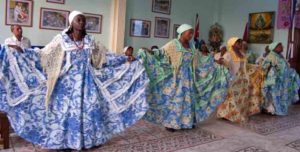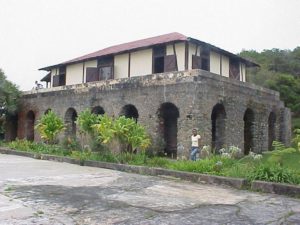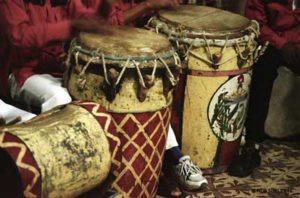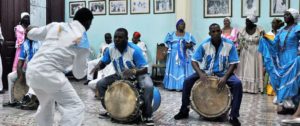El 24 de febrero la ‘Tumba Francesa’ La Caridad de Oriente reconocida por la Unesco al declararla en el 2003 ‘Patrimonio Oral e Inmaterial de la Humanidad’, cumplió 155 años.
Ya suman 8 las generaciones involucradas en ‘esa costumbre’ de los cantos y bailes inspirados en las refinadas evoluciones de la corte versallesca, y sazonados con la sensualidad y el encanto de los tambores africanos.
El origen de esas sociedades que proliferaron en el suroriente cubano se remonta al siglo XVIII cuando en las plantaciones cafetaleras los amos franceses permitían momentos de esparcimiento a los esclavos.
En los días festivos de los Santos Patrones, los hacendados daban esas licencias a los infelices negros que iban sedimentando así la mezcla portentosa de la música y la danza traída por ellos desde sus lejanas tierras -particularmente las dahomeyanas- con las aprehendidas de los galos asentados en el Caribe.
Esas agrupaciones, además de su carácter recreativo, funcionaban para el socorro y la ayuda mutua con manifestaciones también en la religión, la culinaria y la lingüística.
De acuerdo con los investigadores, en las haciendas de los franceses Antonio Venet y Santiago Danger, situadas en las alturas del poblado de El Caney, tuvo sus raíces la Tumba Francesa Lafayette, nombrada así en honor al general abolicionista. En 1905 se dividió en dos y una de ellas, La Caridad de Oriente, sobrevive hasta hoy desde aquel 24 de febrero de 1862.
En los albores del pasado siglo radicó en el barrio de Los Hoyos, donde se sumaron al tronco Venet-Danger nuevos integrantes, atraídos por el magnetismo de sus toques, sus cantos y sus bailes.
Caracterizan su música tres grandes tambores o tumbas, confeccionados con madera y piel de chivo, y los ejecutantes se nombran de acuerdo con su instrumento: mamamier para el premier o principal, secondier para el second (segundo) o bula y cataye, que toca el cata, mientras las cha-cha o marugas acompañan al coro y son de las mujeres. La tambora o requinto va colgada al cuello.
Los bailes, por su parte, son el yuba, de fuerte influencia africana, y el mason, que recuerda a algunos de salones de París como el minuet; además de la tahona, en el cual hay improvisación y los bailarines danzan alrededor de cintas de colores que tejen y destejen.
A diferencia de otras manifestaciones danzarias propias de la región, la de la Tumba Francesa es un espectáculo organizado, complejo y prolongado y puede compararse internacionalmente con la contradanza, género de salón de origen inglés popularizado en América Latina.
En los cantos el coro resulta primordial y la voz guía la lleva el composee, quien improvisa al compás de los toques y el acompañamiento. Esa función ha sido desempeñada siempre en esta Tumba por mujeres.
Vocablos franceses y de origen dahomeyano se confunden con el español en esas interpretaciones.
La intensa musicalidad y el ritmo contagioso de esos acordes permiten fijar con facilidad su contenido, marcado esencialmente por sentimientos de pertenencia, rebeldía y heroísmo, junto a filones de sátira y comicidad.
Batas de cola y corte princesa para las damas, que llevan los cabellos enfundados en pañuelos de colores y camisas de cuello duro y chalecos para los caballeros recuerdan la elegancia de las modas parisinas.
El jigote, el ajiaco, las empanadillas, frituras de mariscos, harina de maíz, carne de cerdo y tubérculos hervidos con aliños de cítricos, acompañados por arroz congrí y bebidas como el ponche, el aguardiente o rones, son los platos típicos que forman el legado culinario de la Caridad de Oriente.
Confluyen algunos padres, hijos y nietos, quienes tienen entre sus paradigmas a las ya desaparecidas Consuelo (Tecla) y Gaudiosa (Yoya) Venet Danger: reina, músico y cantante la primera y presidenta de la sociedad, composee y bailarina la segunda. Con el tiempo partieron físicamente algunos de sus precursores pero los continuadores sostienen el legado.
Llama la atención que el idioma de aquellos inmigrantes galos se fue transformando en creole con fonética africana y sus descendientes continuaron hablándolo junto al español y llamándose a sí mismos franceses.
Por toda esa obstinada persistencia en el tiempo, los valores de esta Tumba trascienden su entorno y son un monumento vivo del sedimento espiritual de la Humanidad. Representan, además, la primera manifestación intangible que en Cuba fue declarada como Patrimonio Mundial.
Todo ello habla de una seria labor de rescate y preservación en la que han participado aquí investigadores de la Casa del Caribe, del Centro provincial de Patrimonio, la Universidad de Oriente y otras instituciones culturales y científicas.
De lo que fue casi dos siglos atrás mimetismo ingenuo de los esclavos hacia sus amos perdura hoy la Caridad de Oriente como huella del devenir histórico ante la cual hoy se inclina esta nuestra vieja y bella ciudad de Santiago de Cuba.
Agencies/ Rad.Habana/Internet Photos/YouTube/ Arnoldo Varona/TheCubanHistory.com
THE CUBAN HISTORY, HOLLYWOOD.
FOLLOW US ON TWITTER AND FACEBOOK. THECUBANHISTORY.COM

SANTIAGO DE CUBA REMEMBERS ITS “FRENCH TUMBA”.
On February 24 the ‘French Tomb’ The Charity of Oriente recognized by Unesco when it declared its 2003 ‘Oral and Intangible Heritage of Humanity’, turned 155 years.
Already there are 8 generations involved in ‘that custom’ of songs and dances inspired by the refined evolutions of the Versailles court, and seasoned with the sensuality and charm of African drums.
The origin of these societies that proliferated in the south-east of Cuba dates back to the eighteenth century when, on the coffee plantations, the French masters allowed moments of relaxation to the slaves.
On the feast days of the Patron Saints, the hacendados gave these licenses to the unfortunate blacks who were sedimenting the portentous mixture of music and the dance brought by them from their distant lands – particularly the dahomeyanas – with the apprehended of the seated cocks In the Caribbean.
These groups, in addition to their recreational character, worked for relief and mutual help with manifestations also in religion, culinary and linguistics.
According to the investigators, on the haciendas of the Frenchmen Antonio Venet and Santiago Danger, located in the heights of the town of El Caney, had its roots the French Tumbler Lafayette, named thus in honor to the abolitionist general. In 1905 it divided in two and one of them, The Charity of the East, survives until today from that 24 of February of 1862.
At the dawn of the last century was located in the neighborhood of Los Hoyos, where new members joined the Venet-Danger trunk, attracted by the magnetism of their touches, their songs and their dances.
Three big drums or tombs, made of wood and goatskin, are characterized by their music, and the performers are named according to their instrument: mamamier for the premier or principal, secondier for the second or bull and cataye, who plays the Tasting, while the cha-cha or marugas accompany the choir and are of the women. The drum or requinto is hanging around the neck.
The dances, on the other hand, are the Yuba, of strong African influence, and the Mason, reminiscent of some of Paris halls like the minuet; In addition to the tahona, in which there is improvisation and the dancers dance around ribbons of colors that weave and unravel.
Unlike other dance manifestations typical of the region, the one of the French Tumba is an organized, complex and prolonged spectacle and can be compared internationally with the contradanza, kind of lounge of English origin popularized in Latin America.
In the songs the chorus is primordial and the lead voice is carried by the composer, who improvises to the beat of the touches and the accompaniment. That function has always been performed in this Tomb by women.
French and Dahomeyan words are confused with Spanish in these interpretations.
The intense musicality and the contagious rhythm of these chords make it easy to determine their content, marked essentially by feelings of belonging, rebellion and heroism, along with satires and comedy.
Gowns and princess cut dresses for ladies, who wear their hair covered in colored scarves and hard-necked shirts and vests for gentlemen recall the elegance of Parisian fashions.
Jigote, ajiaco, empanadillas, seafood fritters, corn flour, pork and tubers boiled with citrus dressings, accompanied by congrí rice and drinks such as punch, aguardiente or rums are the typical dishes that form the Culinary legacy of the Eastern Charity.
Some parents, children and grandchildren, who have among their paradigms to the already disappeared Consuelo (Tecla) and Gaudiosa (Yoya) Venet Danger: queen, musician and singer the first and president of society, composee and dancer the second. Eventually some of their precursors physically departed, but the continuators sustain the legacy.
It is striking that the language of those Galician immigrants was transformed into Creole with African phonetics and their descendants continued to speak next to the Spanish and calling themselves French.
For all that stubborn persistence in time, the values of this Tomb transcend its surroundings and are a living monument of the spiritual sediment of Humanity. They also represent the first intangible manifestation declared World Heritage in Cuba.
All this speaks of a serious task of rescue and preservation in which researchers from the Casa del Caribe, the Provincial Heritage Center, the Universidad de Oriente and other cultural and scientific institutions have participated.
From what was almost two centuries ago, the naive mimicry of the slaves towards their masters today remains the charity of the East as a mark of historical evolution before which today our beautiful and beautiful city of Santiago de Cuba is leaning.
Agencies/ Rad.Habana/Internet Photos/YouTube/ Arnoldo Varona/TheCubanHistory.com
THE CUBAN HISTORY, HOLLYWOOD.







